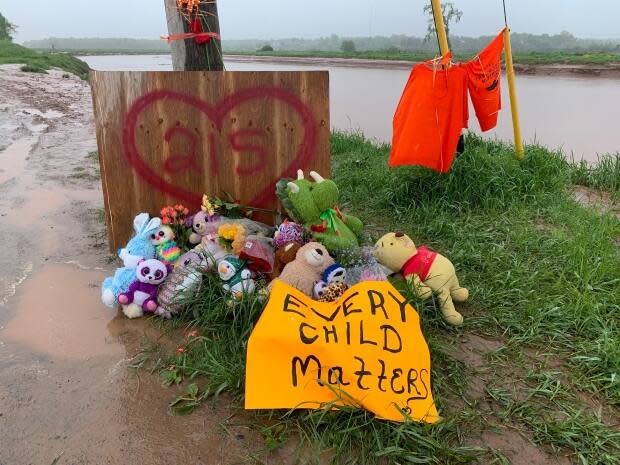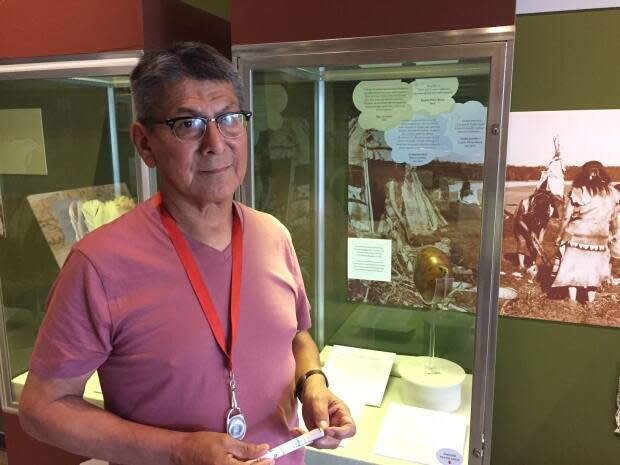'A huge task': Search will take time at former Shubenacadie residential school site

WARNING: This story contains details some readers may find distressing.
Guided by elders and survivors, a massive search continues at the site of the former Shubenacadie residential school using technology that surveys the land from above and below.
It's complex and painful work that archeologists say could take some time as they make their way across roughly 57 hectares, directed by community members from Sipekne'katik First Nation.
The Shubenacadie residential school operated between 1929 and 1967, affecting the lives of thousands of Indigenous children from across the Maritimes, as well as their families and descendents.
"People don't realize the magnitude of the project we've taken on both physically and mentally, emotionally," ethnologist Roger Lewis told CBC Radio's Mainstreet on Tuesday. "It's a huge task."
The school building was demolished in 1986 and the area is now home to a plastics factory and farmland. Some of the property is hard to access and covered in brush that's being cleared away.
Lewis, a curator with the Nova Scotia Museum, is a member of Sipekne'katik and a survivor of the school. He's leading the search with archeologist Jonathan Fowler from Saint Mary's University on behalf of the First Nation.
"I can visually see things on that property that aren't there right now so ... the ghost of that building is kind of embedded in my memory," Lewis said.
The National Centre for Truth and Reconciliation lists the names of 16 children who died while at the school and community members have said they fear children were buried at the site.

Indigenous communities across Canada are undertaking similar searches after Tk'emlúps te Secwépemc First Nation in Kamloops, B.C., announced the discovery of what are believed to be the unmarked burial sites of 215 children at a former residential school.
"There's a lot of emotion," Lewis said, "And people come up and they say, 'OK, I heard this. Maybe you want to look at the north side of that property, the east side or the west side so there's a lot of memories we're dealing with."
Drone, satellite imagery used
The team recently sent up a drone to capture high-resolution footage of the area, which they will compare with historical aerial photography and satellite images.
As of Tuesday they'd covered about eight hectares of land with ground-penetrating radar to target certain areas for detailed investigation, Fowler said.
Previous archival research shows there was a late-18th century sawmill and a Victorian-era farm in the area. These past histories, as well as what happened after the school closed all factor into the archeological survey, Fowler said.
The residential school itself had several outbuildings and Fowler doesn't see their work "reaching a conclusion rapidly." Once they have generated a set of information they will bring it community members for their feedback and direction and will likely return to the site again, he said.

"It's not as easy as simply engaging in a search," Fowler said. "We really do have to take a holistic approach, a comprehensive approach and that's the approach that the community has asked us to take."
While the search includes the use of ground-penetrating radar, the method used in Kamloops, Fowler believes there may be some differences as well.
"I've heard it said that in some other cases we're dealing with sites that had known cemeteries, in some cases demarcated. It's a different process to what we're engaged in," he said.

Last month, the Mi'kmaq Rights Initiative said some locations at the Shubenacadie site had already been examined. It said no graves or human remains have been found so far, but the search continues.
Lewis asked for patience as they continue with the difficult work ahead.
"There's a lot of pain, a lot of story attached to that site and what I do is try to separate my emotions from my professionalism," he said. "I'm charged with doing a job there on behalf of the community, and I try to keep it that way."
Support is available for anyone affected by their experience at residential schools, and those who are triggered by the latest reports.
A national Indian Residential School Crisis Line has been set up to provide support for former students and those affected. People can access emotional and crisis referral services by calling the 24-hour national crisis line: 1-866-925-4419.
MORE TOP STORIES

 Yahoo Movies
Yahoo Movies 